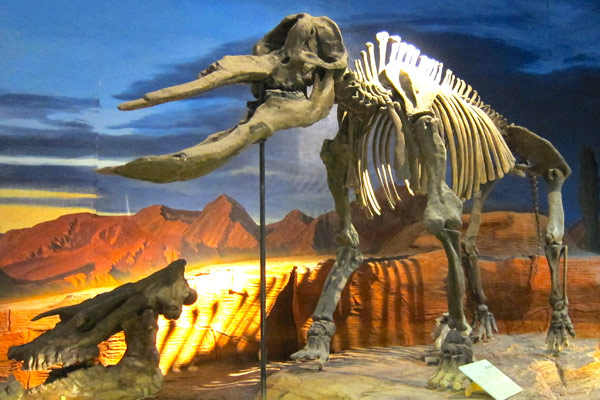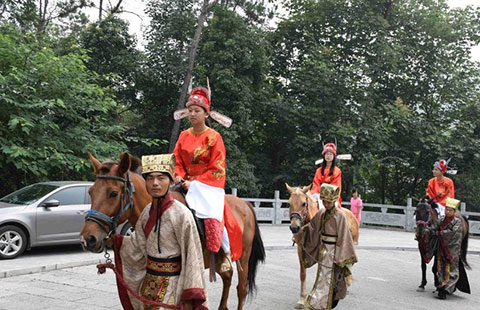New life in Turpan's dead zones
Updated: 2015-07-10 10:48
By Erik Nilsson in Xinjiang(China Daily USA)
|
||||||||
|
 |
|
The Turpan Museum’s displays exhibit not only the region’s history but also its prehistory. |
Rich tapestry of old, new cultures on ancient and emergent routes
The Easter Bunny shows how the ghost towns in China's westernmost incarnations are being reincarnated as international attractions, and evoke the merits of multiculturalism, which propelled their prominence, and the perils of intolerance, which forced their falls.
The Easter Bunny came to town - specifically an ancient ghost town in the Xinjiang Uyghur autonomous region.
When the day celebrating the resurrection of Jesus coincided with the Chinese Tomb Sweeping Day in April, our 3-year-old scoured Yar's ruins for candy-packed plastic eggs stashed by a pagan hare.
It dawned on us that the fact we staged the egg hunt in the dead city of Yar shows how its ancient position as a multicultural Silk Road nexus is breathing new life into its international appeal.
It wove the narrative thread hemming Turpan's rich tapestry of past and present cultures along the ancient and emergent routes.
The site's past multiculturalism sired the city that lured us there.
And we contributed to its revived internationalism by observing our foreign festival among its remnants. Chinese unacquainted with the egg-stashing custom gawped.
The bunny - a symbol of birth adopted by Christians when they co-opted the pagan equinox tribute to the fertility goddess Eostre - that day played by two nonreligious parents from the United States, celebrated the festivals' confluence by stashing eggs (shamanic fecundity totems) in a massacred city's Buddhist cave temple.
The mythical cottontail did so when two distinct lunar calendars collided so Easter coincided with the Chinese festival hailing from the ancient ancestral worship linked to folk religions, Buddhism, Taoism and Confucianism.
That is, in a now predominantly Islamic swathe where Manichean and Nestorian beliefs previously prevailed.
Yar was a global village before the term existed, but intolerance made it a mass grave.
Its heterogeneous composition propelled prosperity for 1,600 years.
Then Islamic Mongolian conquerors incinerated Yar to enforce religious homogeny.
This left what Hungarian-British archeologist Aurel Stein a century ago called "a maze of ruined dwellings and shrines carved out for the most part from the loess soil".
Stein's depiction remains apt.
This early legacy attracts a growing plethora of modern peoples from further afield - even US nationals.
Europeans didn't "discover" the "New World" for nearly a century after Yar was decimated.
But their ancestors (in this case, our family) have since zipped the other way across the planet to this westernmost strip of the Far East. And not just to hide eggs.
Thus, Turpan's ancient ghost cities of Yar and nearby Qocho are being reincarnated and repopulated by a multiplying diversity of sojourners.
These ancient trade hubs were vital nodes of the 5,000-kilometer Tianshan Silk Road corridor that linked China with modern Kazakhstan and Kyrgyzstan. Today's Turpan is poised to become a central nexus of the embryonic Silk Road Economic Belt.
eriknilsson@chinadaily.com.cn

 Top gaokao scholars saddle up for a ride in the park
Top gaokao scholars saddle up for a ride in the park
 Girl who shoots straight with bow and arrow
Girl who shoots straight with bow and arrow
 Ten photos you don't wanna miss - July 10
Ten photos you don't wanna miss - July 10
 Forum Trends: Should we pay children to study?
Forum Trends: Should we pay children to study?
 Bereaved seniors turn attention to grandchildren
Bereaved seniors turn attention to grandchildren
 Unusual but true: sleep in a transparent glass room clinging to cliff
Unusual but true: sleep in a transparent glass room clinging to cliff
 24-year-old ethnic Chinese girl runs for US Congress
24-year-old ethnic Chinese girl runs for US Congress
 Plane makes emergency landing after fire
Plane makes emergency landing after fire
Most Viewed
Editor's Picks

|

|

|

|

|

|
Today's Top News
Leaders agree on partnership blueprint
New Development Bank launched in Ufa
IMF keeps 6.8% China growth view
Leaders agree on partnership blueprint
More tariffs on Chinese solar panels
Students study depression to raise suicide awareness
Official denial raises doubts over '40-year-old meat' story
Yuan hit by turmoil in the market
US Weekly

|

|







